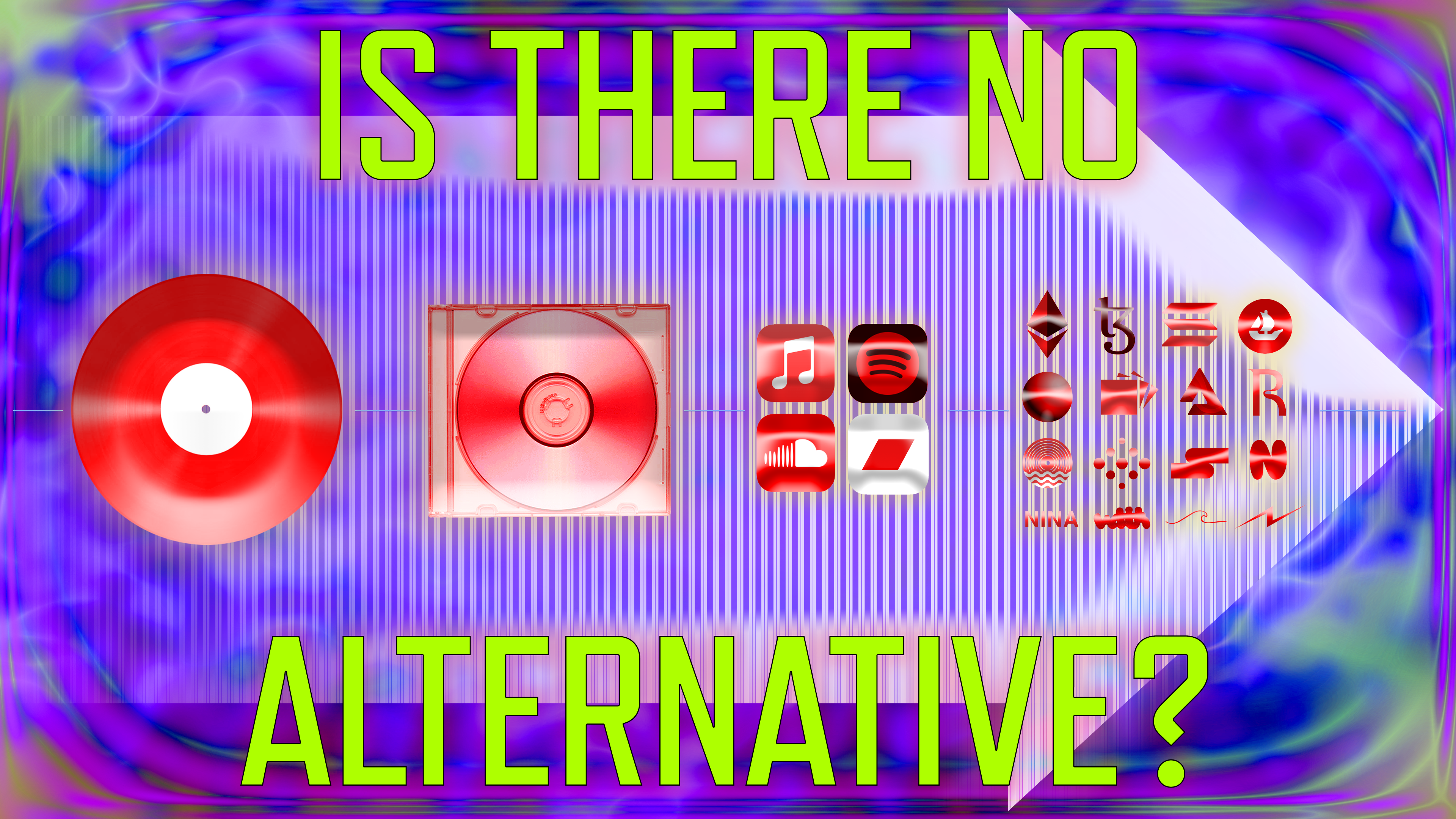- Aleph
- Ariel LeBeau
- Austin Robey
- David Blumenstein
- David Ehrlichman
- David Kerr
- Devon Moore
- Dexter Tortoriello
- Drew Coffman
- Drew Millard
- Eileen Isagon Skyers
- FWB Staff
- Greg Bresnitz
- Greta Rainbow
- Ian Rogers
- Jessica Klein
- Jose Mejia
- Kelani Nichole
- Kelsie Nabben
- Kevin Munger
- Khalila Douze
- Kinjal Shah
- LUKSO
- Lindsay Howard
- Maelstrom
- Marc Moglen
- Marvin Lin
- Mary Carreon
- Matt Newberg
- Mike Pearl
- Mike Sunda (PUSH)
- Moyosore Briggs
- Nicole Froio
- Ruby Justice Thelot
- Simon Hudson
- Steph Alinsug
- The Blockchain Socialist
- Willa Köerner
- Yana Sosnovskaya
- Yancey Strickler
- iz

Mon Mar 13 2023

The market for non-fungible tokens (NFTs) may have collapsed over the last year, but independent musicians are still minting. Is this because the modern musician is obsessed with cartoon gorillas, pixelated characters, and arcane web3 infrastructure experiments? Perhaps tweaking parameters in Ableton Live all day became tiresome, and the decentralized economy became their true passion. Or maybe, just maybe, it’s that the other revenue options for musicians in a post-pandemic, inflationary economy, in which media is free for everyone with a data connection, have dried up.
Even concert tours, once the keystone for serious musicians, are being canceled or truncated. The reason? Live music has become a break-even financial endeavor or even a cost center. Furthermore, fifteen years into the streaming revolution, many musicians are understandably still unsatisfied about earning as little as a third of a penny per stream.
Enter web3 and NFTs. With established hip-hop and electronic artists, along with the occasional newcomer, continuing to post five- and six-figure drops, web3 has emerged as a holy grail of sorts, a mystical medicine that will cure all the systemic problems that ail independent musicians trying to find their footing in the digital economy today. But should we buy into the dream? Or are Music NFTs just another pot of gold at the end of the rainbow, another digital transformation promising musicians the ability to capture the value of their work but ultimately only benefiting a small group of artists and powerful corporations?
Given all the high-profile crypto scandals over the past year, web3 seems like it would be the last place an independent musician would want to be. But the begrudging consensus remains that the music industry is broken and that musicians face harsh realities in attempting to earn a living from their work, regardless of talent or effort. Simply distributing music on major streaming platforms is clearly not sufficient, even for seasoned professional musicians, who are compelled to sit through YouTube-hawked courses for “Getting on Playlists” if they want to begin generating more than a few dozen streams worldwide by anyone other than click inflators sourced on Fiverr. A headline from last year noted that in 2021, “Nearly 80% of artists on Spotify [had] fewer than 50 monthly listeners.”
How much less than 50? It could be far less, and we may never know precisely. While Spotify has made a ritual out of sharing every detail of our listening habits with us at the end of every year, it’s hard to come by data on how streaming payouts are calculated at a given point in time. However, judging by the continued calls for Spotify to increase its payouts to a penny per stream, it is clear that in most cases, the numbers are nothing to write home about for the people who are supplying the app with all that music. Unless, perhaps, you are one of more than 1000 artists netting over $1,000,000 in streaming revenue a year, though individual musicians typically take home far less than this once labels, bandmates, and other rights holders are accounted for.
Here, in the doldrums of a global pandemic, was a chance to think deeper about what it meant to be a musician and to question if perhaps we had been going about it the wrong way all along.
But let us imagine for a moment that it is 50 monthly listeners for the bulk of musicians on the world’s leading streaming platform. Fifty people would fill a small café with standing room only. Fifty people could pack a pub. If 50 people showed up to a flat, someone might file a noise complaint. Forget 1,000 true fans: 50 is no small feat when you consider it from this perspective. Moreover, 50 folks buying concert tickets at five or ten bucks a pop is not bad for a night’s work. Now, imagine 50 NFT collectors spending multiples of that on a digital collectible — well, that could be enough to cover rent for a month or two, with money left over for a new MIDI controller.
The fact remains that most artists, including people with way more than 50 monthly streams, see streaming as little more than a marketing tool. It can help you find new fans, and in certain cases (such as getting listed on a top playlist), generate a massive amount of traffic, traffic that can be pushed toward revenue generators like live concerts, merchandise, influencer income, and, potentially, digital collectibles like NFTs. Spotify’s just-announced new interface even appears to lean into this dynamic, with the introduction of new merch and concert discovery tools.
So while Spotify is incredibly lucrative for members of the “Billions Club” — a playlist featuring the 372 songs that, as of this writing, have racked up more than a billion streams — for most of us, the platform is more like the Library of Congress for music: a big, monolithic storehouse of intellectual property where one could spend 500 years doing nothing else than listening to music and still not come close to hearing every piece of audio housed within the company’s fluorescent-lit server farms (assuming one has a paid subscription to prevent ads from interrupting).
So in early 2021, when buskers were scrolling the headlines between Guns N’ Roses covers, they perked up upon seeing that a digital artist had sold a JPEG at auction for nearly seventy million dollars with something called an NFT. Stories of musicians tapping into this new technology trickled out slowly at first, then more frequently: one EDM artist found a way to hold a gamified NFT auction, raking in nearly twelve million dollars from an album reissue.
The news felt like fissure in the matrix, a beam of light carrying tales of actual musicians selling recorded music for real (or at least fungible) currencies — cryptographic tokens that, in turn, were bursting in valuation. Musicians, or at least those with a techno-optimist streak, wanted in. So they started Googling “smart contracts” and “on-chain royalty splits.” They started watching tutorials for “minting on OpenSea” and “generative music.” Seemingly overnight, they became amateur musicologists, internet freedom activists, and decentralization evangelists.
Here, in the doldrums of a global pandemic, was a chance to think deeper about what it meant to be a musician and to question if perhaps we had been going about it the wrong way all along. And now that Twitter’s innovation team had successfully copycatted Clubhouse functionality to allow actual human voices to communicate in real time, a new town hall was born where musicians could talk openly about how, why, and where to mint NFTs. It was a virtual Woodstock of sharing, with fewer mudbaths.

Music-centered NFT platforms emerged, promising musicians a Plan B. All of a sudden everyone was singing campfire songs, albeit through N-95 masks, about how we all ought to collaborate and jump into this new paradigm together. It was as easy as getting a digital wallet browser extension, swapping altcoins, and paying hundreds of dollars in gas fees so that a piece of music you were proud of could appear on an early-stage NFT marketplace — often unsearchable, unfindable, and sometimes, on closer inspection, not actually listed at all. (Note to reader: If anyone can locate “The Halving,” a short piece featuring variations on a synthesized piano riff, minted to the Ethereum blockchain in early 2021, and for which multiple gas fees were paid, the author would be very appreciative).
It has become something of a given that musicians — and all artists, generally — must become entrepreneurs, marketers, and shameless self-promoters to get anywhere in the byzantine world of the digital media economy. Now, they also had to be programmers, navigating half-baked user interfaces, digital wallets, and decentralized file solutions cooked up by nameless, faceless Gen Z coders in their second year of Computer Science. But this was the future and the future was here, so why not try?
And so they did. The most successful working musicians in web3, barring those with already massive followings, tried everything before they found a method that stuck. They tried minting music to grab-bag repositories where most NFTs go to languish in the secondary market, presenting their carefully crafted music pieces next to frog memes. They applied to curated music NFT Marketplaces with a strategic combination of crossed fingers and Twitter DMs. Some of them invested in designing their own custom minting websites, forging a path once reserved for seed-funded Stanford MBAs and becoming veritable tech entrepreneurs.
The foregone conclusion in Twitter Spaces, the scene’s de facto digital town square, seemed to be that NFTs would be a solution that could be leveraged by thousands and thousands of musicians — though the early adopters, as the conventional wisdom goes, were likely to benefit most. As it turned out, though, making money in web3 wasn’t that easy.
All of a sudden, musicians found themselves adding another bullet point to their CV: community management.
As the NFT market slowed to a near standstill in late 2022, I decided to look into what was responsible for the prodigious growth of music NFTs in 2021. What I found was striking. Sifting through the available data in the Water & Music database, an image of a virtual genre duopoly emerged: three quarters of all Music NFTs in that year came from just two genres: hip-hop and EDM. This insight sparked an idea for a collaborative project in which I lead contributors to interview 19 web3 music artists across the long tail of musical genres on their creative process, platforms of choice, promotional strategies, and other strategic considerations.
What we found, regardless of genre, was that web3 music artists could never just go on auto-pilot. They were focused on building and constantly engaging with a collector community, posting music NFTs to numerous platforms, and constantly offering new utility for their releases, all with varying degrees of success and no clearly forged path to follow.
One of the biggest challenges these early music NFT pioneers had to contend with is something I describe in the research piece as the “one-way chasm.” Musicians looking to make money in web3 had to learn how to market their work to a whole new audience: crypto-native collectors who were already in the habit of buying NFTs. While these new fans would gladly follow musicians on the standard Web 2.0 channels, the same could not be said of the artist’s pre-existing fans and followers, who would not be easily compelled to jump the other way and purchase NFTs. This meant that the pressure to build up an entirely new following of collectors and supporters within the web3 space was intense. Cellist Kaitlyn Raitz, one of the artists we spoke to in our research, said that she spent nearly every day in Twitter Spaces promoting her generative music NFT project. “It’s not sustainable in the long term,” she said.
All of a sudden, musicians found themselves adding another bullet point to their CV: community management. Whether this took the form of trying to herd collectors into o Discord servers and Twitter Spaces, coming up with incentives for NFT holders like lifetime access to concerts and one-on-one Zoom calls, or coddling collectors with promises of future whitelists and ambitious roadmaps, this could be almost as time-consuming as producing the music itself. It didn’t help that “shillers,” as they came to be known, were simultaneously the bane of this emerging creative economy. While Twitter spaces in particular were a good place to tap into a captive audience of potential patrons, one was expected to listen and learn, without monopolizing this sacred rhetorical space. Given the chance, you could mention your project. But posting a link to it would get you booted from the room and endless scorn.

Despite these challenges, musicians continued to mint NFTs through the bear market of 2022, now with lower gas fees and a plethora of marketplace options. Inconvenient developments, such as once-leading music NFT marketplaces like Mint Songs suddenly going down, with no reason given, did little to deter enthusiasm. (Nor did it stop a rebellious legacy brand from the days of MP3 file-sharing from acquiring the platform). Morale held steady even as Ethereum prices and trade volume dipped, the alt-coin feeding frenzy revealing only a bony carcass of underlying economic fundamentals. This trough in the post-fiat economy was temporary, we reasoned, and NFTs were going to come back in the next wave of crypto exuberance. And anyway, what were the viable alternatives?
In 2023, the question that remains on everyone’s mind is whether this new technology will ever represent a solution for musicians at scale, and if so, how. One major issue confronting the newbie web3 musician, at least at this early stage, is marketplace choice: The sheer number of options for minting your music makes choosing one more perplexing than selecting a carton of oat milk at Whole Foods. Then there is the not-so-insignificant matter of pricing: with no standardization, an audience’s willingness to pay is anyone’s guess. Should an NFT be priced like a physical recording, such as a CD or a vinyl record? Should it be priced as low as possible to encourage sales and then hope for secondary royalties? Should it be priced at ungodly levels in the hopes that it’s seen as a rare opportunity, perhaps with some additional utility in the form of a swanky afterparty or a backstage pass?
Is it so problematic if Music NFTs remain niche curiosities? Is mass adoption always the necessary outcome of a technological innovation?
All of this nebulous territory creates the risk of musicians succumbing to analysis paralysis, throwing up their hands, and deciding to throw that damn song up on a streaming platform after all. At least your fans could enjoy the music there without much hassle beyond enduring an ad from Old Spice. Did finding an alternative have to be this complicated? Even Muse, the famous rock band, did not have the heft to lead the way with the “Digital Pressing” of their 2022 record , which sold out in 25 minutes and helped propel the record to number one in the UK in its first week of release (thanks in part to the fact that the NFT edition was chart-eligible). Though the edition seemed poised to set a new standard for the pricing and format of album NFTs (copies sold for 20 GBP each, mirroring the cost of a standard vinyl record), we have yet to see the model achieve widespread adoption.
Of course, that doesn’t mean there aren’t forces with the power to set a new industry-wide agenda. With Warner Music partnering with Probably Nothing to launch a web3 music label, Universal Music Group joining hands with its once-arch enemy LimeWire as the latter reemerges as a music NFT platform, and Live Nation betting on the value of blockchain-based ticket stubs, there is reason to believe that the most powerful corporations in the industry will figure out how to harness these tools for their own benefit — making all of that utopian banter about freeing the music industry from its monopolistic overlords sound about as naive as it did in the age of P2P pirating.
At the same time, maybe there’s another way of imagining the future of music NFTs. Is it so problematic if Music NFTs remain niche curiosities? Is mass adoption always the necessary outcome of a technological innovation? Perhaps we will see NFTs (potentially redubbed as “digital collectibles”) go the way of vinyl records, which fell into obsolescence in the 80s but are now seeing a resurgence as collector’s items. The data tells an interesting story to support the idea that collecting is more about showing allegiance than anything else: In a 2022 survey of thousands of vinyl collectors, music sales data provider Luminate found that fully one half didn’t even own a record player.
Could the whole of the listening populace eventually begin accumulating digital items like Gen Xers in their heyday packing a Tower Records? It’s impossible to say, but it’s clear that NFTs hold great promise — especially for musicians looking to supplement existing or dwindling monetization opportunities, and especially if enterprising companies manage to crack the code of usability, standardization, and bridging the “one-way chasm.” Our measure for success will be when the musician who packs a cafe with 50 fans doesn’t also have to be the one working the espresso machine when the concert is done.
Marc Moglen is a business development strategist working at the intersection
of web3 and music. He’s also a composer, songwriter, and bassist
writing on the music industry.
Images by Eric Chen


